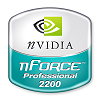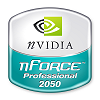NVIDIA's nForce4 Professional Launch
With the launch of nForce4 SLI as the range-topping flagship for NVIDIA's consumer core logic and the subsequent introduction of both SLI and Ultra variants on shipping mainboards, AMD's Socket 940 processors have been left high and dry until today. Well, until last Wednesday, but I've been both tardy and investigative in the meantime, as I write up the launch.The announcement wasn't unexpected; I mentioned nForce4 Professions a couple of times during my look at nForce4 for Socket 754 and Socket 939 and I told you it was soon. What has been unexpected is just how nForce4 Professional is constructed (it's not just one ASIC) and what it enabled for the Socket 940 market. Is it time for you to throw Opteron into Pricewatch and consider some registered DDR memory? It's certainly given me cause to consider doing those things, read on as I explain why.
nForce4 PRO - Not just a single chip
It's not more than a single ASIC as you'd usually expect; there's no north and south bridges. Rather, the HyperTransport links on AMD's current AMD64 processor lineup allow two variants on the basic nForce4 theme to come together to create truly powerful computer systems. In step nForce4 Professional 2200 and nForce4 Professional 2050.
nForce4 Professional 2200 is the same physical CK8-04 product that nForce4, nForce4 SLI and nForce4 Ultra. It's just advertised as a Pro 2200 to the mainboard components by on-package configuration. Each variant shares the same feature set and performance and all that distinguishes them is their CPU support and whether they officially support SLI. It's an adaptable ASIC that NVIDIA can customise for four markets and four price points, using a single fabricated bit of silicon.
nForce4 Professional means support for Socket 940 processors. Opteron and older Athlon FX-51 and FX-53 processors slip into that socket and bestow your system with the same AMD64 power you'll get in the mainstream, just with a different pinout, and in the case of Opteron, a different name.
After that, you've got a 20-lane PCI Express root host, which can be partitioned any number of ways to complete the PCI Express slot configuration on the mainboard. With nForce4 Professional that means a set PEG16X slot for graphics using 16 lanes, with the other quartet available for peripheral connection. There's no SLI split with nForce4 Professional that sets a pair of 8-lane bundles to be routed via a continuity connector, you just get sixteen lanes for graphics the whole time.
You also get NVIDIA's latest disk controller. Two separate SATA300 controllers lie on the ASIC, each supporting a pair of SATA300 devices for four in total. You've got a 3GHz clock generator running the data stream on the controller, giving 300MB/sec of bandwidth per controller, after signal correction and encoding overheads. Read more about that on the linked page to get the low down on command queuing and RAID support inside the controller.
Their new Gigabit Ethernet controller with hardware firewall also shows up, bestowing the mainboard it resides on with the most advanced on-chip Gigabit Ethernet controller doing the rounds right now. Sat on its own bus with memory controller access and CPU offload of a whole bunch of TCP/IP stack operations, along with the firewall, it's a highlight of nForce4.
Joining the party is 10 ports of USB2.0 HighSpeed and the cool software that NVIDIA supply to get the best from everything, which includes nTune, NVRAID and the ActiveArmour driver and interface.

nForce4 Professional 2050 is a CK8-04 with the USB port controller disabled. That's it. It's 2200 with an unusable USB2.0 controller, I kid you not. The wonders of product differentiation and HyperTransport let you configure it as follows.
Putting the two together
To put the two together on one mainboard, which would give you 40 lanes of PCI Express with 32 just for graphics and 8 for peripherals, native support for eight SATA300 devices, two Gigabit Ethernet controllers and 10 USB2.0 ports (and two audio interfaces), you need two Opterons.So single Opteron or Athlon FX Socket 940 mainboards can only enjoy a single 2200, but two Opterons, given that each has one of its three HyperTransport links available for downstream connection to other HyperTransport devices, can take advantage.
Two Opterons occupy your mainboard, you hang a 2200 off the first, a 2050 off the second and you can access all the functionality of each ASIC in the same system. HyperTransport lets you tunnel traffic through each device. So if the second CPU wants to access data from the disk controller on the 2200 connected to the first CPU, that's no problem. If the first CPU needs to squirt data over the 2050's network controller, that's a piece of cake too.
Got four Opterons? Hang a 2200 off the first and a 2050 off each of the other processors for 80 lanes of PCI Express (I'm not kidding), four GigE controllers and 16 native SATA300 devices with fast links to the processors. Sixteen. Natively. Eight-way Opteron, due to how you need to connect the two coherent HyperTransport links for communication with another Opteron, can only spare four HT links for I/O, allowing it the same nForce4 ASIC configuration as four-way enjoys.
Can you start and see the appeal for AMD and NVIDIA's enterprise and professional workstation customers looking to integrate all that's good about nForce4, of which there's plenty to shout about, into their systems?
NVIDIA's partners certainly can with Sun, Newisys, Wistron, Inventec, Iwill and Tyan all having nForce4 Professional designs ready to rock and roll as I type this, shipping to customers that make up the six million unit server market, massive professional workstation market clamouring for this kind of Opteron and PCI Express integration.
Quadro
NVIDIA, during their presentation to press on nForce4 Professional, were also keen to tie in PCI Express Quadro to the product information. Quadro FX 4400 is their PCI Express part based on the NV45 processor we've come to know and love over the past eight and a half months.More on Quadro FX 4xxx very soon at HEXUS as I evaluate their workstation performer.
Summing it up
Socket 940 just got sexy again. Uniprocessor Opteron and Athlon FX systems get PCI Express and arguably the best disk and networking controllers on the market. SMP Opteron gets everything in counts of two or four, over and above the base CK8-04 configuration and feature set. Board partners seem to be ignoring uniprocessor for the time being, dual and quad Opteron getting masses of nForce4 love from the likes of Tyan.I'll grab myself a pair of Opterons and some of the first mainboards to hit the market, to let you know just how nForce4 Professional's paper promise holds up the cold light of benchmarks and analysis. A 2200 + 2050 mainboard looks exactly what the doctor ordered for the workstation professional, and the server vendor looking to cram lots of I/O bandwidth into a single system.
If you want a look at NVIDIA Sledgehammer CRB - their reference platform for nForce4 Professional - click the image below.














